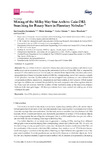Mining of the Milky Way Star Archive Gaia-DR2: Searching for Binary Stars in Planetary Nebulae

Use este enlace para citar
http://hdl.handle.net/2183/26573Colecciones
- Investigación (FIC) [1685]
Metadatos
Mostrar el registro completo del ítemTítulo
Mining of the Milky Way Star Archive Gaia-DR2: Searching for Binary Stars in Planetary NebulaeFecha
2020-08-31Cita bibliográfica
González-Santamaría, I.; Manteiga, M.; Dafonte, C.; Manchado, A.; Ulla, A. Mining of the Milky Way Star Archive Gaia-DR2. Searching for Binary Stars in Planetary Nebulae. Proceedings 2020, 54, 52. https://doi.org/10.3390/proceedings2020054052
Resumen
[Abstract]
The aim of this work is to search for binary stars associated to planetary nebulae (ionized stellar envelopes in expansion), by mining the astronomical archive of Gaia DR2, that is composed by around 1.7 billion stellar sources. For this task, we selected those objects with coincident astrometric parameters (parallaxes and proper motions) with the corresponding central star, among a sample of 211 planetary nebulae. By this method, we found eight binary systems, and we obtained their components positions, separations, temperatures and luminosities, as well as some of their masses and ages. In addition, we estimated the probability for each companion star of having been detected by chance and we analyzed how the number of false matches increase as the separation distance between both stars gets larger. All these procedures have been carried out making use of data mining techniques.
Palabras clave
Gaia DR2
Planetary nebulae
Binary stars
Astrometry
Planetary nebulae
Binary stars
Astrometry
Descripción
This article belongs to the Proceedings of 3rd XoveTIC Conference
Versión del editor
Derechos
Atribución 4.0 Internacional
ISSN
2504-3900






